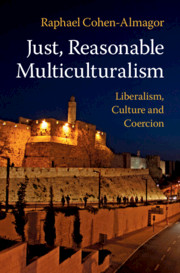Book contents
- Just, Reasonable Multiculturalism
- Just, Reasonable Multiculturalism
- Copyright page
- Dedication
- Contents
- Figures
- Acknowledgements
- Theory of Just, Reasonable Multiculturalism
- Introduction
- Part I Theory
- 1 Just Liberal Democracy
- 2 Reasonable Multiculturalism
- 3 Compromise and Deliberative Democracy
- 4 Coercion
- Part II Interference in Minority Affairs: Physical Harm
- Part III Interference in Minority Affairs: Non-physical Harm
- Part IV Country Case Studies
- Conclusion
- Select Bibliography
- Index
4 - Coercion
from Part I - Theory
Published online by Cambridge University Press: 19 July 2021
- Just, Reasonable Multiculturalism
- Just, Reasonable Multiculturalism
- Copyright page
- Dedication
- Contents
- Figures
- Acknowledgements
- Theory of Just, Reasonable Multiculturalism
- Introduction
- Part I Theory
- 1 Just Liberal Democracy
- 2 Reasonable Multiculturalism
- 3 Compromise and Deliberative Democracy
- 4 Coercion
- Part II Interference in Minority Affairs: Physical Harm
- Part III Interference in Minority Affairs: Non-physical Harm
- Part IV Country Case Studies
- Conclusion
- Select Bibliography
- Index
Summary
Coercion involves two or more parties who are in conflict and whose relationships are complex and uneasy. Generally speaking, people resent coercion and, when possible, rebel against it. This chapter differentiates between circumstantial coercion and person-based coercion, between coercion and brute forms of oppression, and between benevolent and malevolent coercion. It discusses the coercer’s intentions and specifically addresses the issues of paternalistic coercion, coercion via a third party and self-coercion. Two further distinctions are offered: between internalised and designated coercion, and between coercion enforced by a minority versus coercion imposed by a majority.
Keywords
- Type
- Chapter
- Information
- Just, Reasonable MulticulturalismLiberalism, Culture and Coercion, pp. 88 - 108Publisher: Cambridge University PressPrint publication year: 2021

